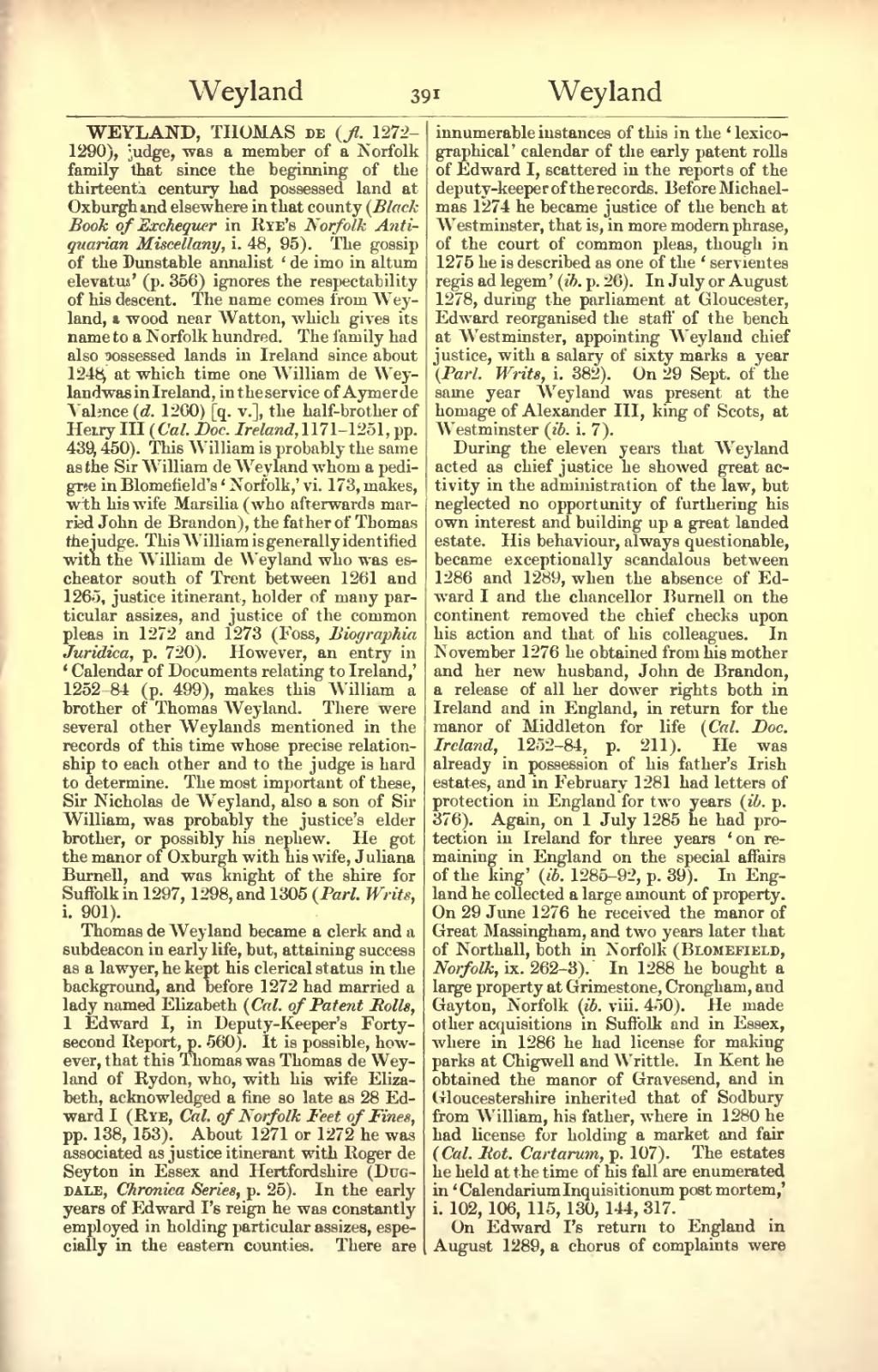WEYLAND, THOMAS de (fl. 1272–1290), judge, was a member of a Norfolk family that since the beginning of the thirteenth century had possessed land at Oxburgh and elsewhere in that county (Black Book of Exchequer in Rye's Norfolk Antiquarian Miscellany, i. 48, 95). The gossip of the Dunstable annalist ‘de imo in altum elevatus’ (p. 356) ignores the respectability of his descent. The name comes from Weyland, a wood near Watton, which gives its name to a Norfolk hundred. The family had also possessed lands in Ireland since about 1248, at which time one William de Weyland was in Ireland, in the service of Aymer de Valence (d. 1260) [q. v.], the half-brother of Henry III (Cal. Doc. Ireland, 1171–1251, pp. 439, 450). This William is probably the same as the Sir William de Weyland whom a pedigree in Blomefield's ‘Norfolk,’ vi. 173, makes, with his wife Marsilia (who afterwards married John de Brandon), the father of Thomas the judge. This William is generally identified with the William de Weyland who was escheator south of Trent between 1261 and 1265, justice itinerant, holder of many particular assizes, and justice of the common pleas in 1272 and 1273 (Foss, Biographia Juridica, p. 720). However, an entry in ‘Calendar of Documents relating to Ireland,’ 1252–84 (p. 499), makes this William a brother of Thomas Weyland. There were several other Weylands mentioned in the records of this time whose precise relationship to each other and to the judge is hard to determine. The most important of these, Sir Nicholas de Weyland, also a son of Sir William, was probably the justice's elder brother, or possibly his nephew. He got the manor of Oxburgh with his wife, Juliana Burnell, and was knight of the shire for Suffolk in 1297, 1298, and 1305 (Parl. Writs, i. 901).
Thomas de Weyland became a clerk and a subdeacon in early life, but, attaining success as a lawyer, he kept his clerical status in the background, and before 1272 had married a lady named Elizabeth (Cal. of Patent Rolls, 1 Edward I, in Deputy-Keeper's Forty-second Report, p. 560). It is possible, however, that this Thomas was Thomas de Weyland of Rydon, who, with his wife Elizabeth, acknowledged a fine so late as 28 Edward I (Rye, Cal. of Norfolk Feet of Fines, pp. 138, 153). About 1271 or 1272 he was associated as justice itinerant with Roger de Seyton in Essex and Hertfordshire (Dugdale, Chronica Series, p. 25). In the early years of Edward I's reign he was constantly employed in holding particular assizes, especially in the eastern counties. There are innumerable instances of this in the ‘lexicographical’ calendar of the early patent rolls of Edward I, scattered in the reports of the deputy-keeper of the records. Before Michaelmas 1274 he became justice of the bench at Westminster, that is, in more modern phrase, of the court of common pleas, though in 1275 he is described as one of the ‘servientes regis ad legem’ (ib. p. 26). In July or August 1278, during the parliament at Gloucester, Edward reorganised the staff of the bench at Westminster, appointing Weyland chief justice, with a salary of sixty marks a year (Parl. Writs, i. 382). On 29 Sept. of the same year Weyland was present at the homage of Alexander III, king of Scots, at Westminster (ib. i. 7).
During the eleven years that Weyland acted as chief justice he showed great activity in the administration of the law, but neglected no opportunity of furthering his own interest and building up a great landed estate. His behaviour, always questionable, became exceptionally scandalous between 1286 and 1289, when the absence of Edward I and the chancellor Burnell on the continent removed the chief checks upon his action and that of his colleagues. In November 1276 he obtained from his mother and her new husband, John de Brandon, a release of all her dower rights both in Ireland and in England, in return for the manor of Middleton for life (Cal. Doc. Ireland, 1252–84, p. 211). He was already in possession of his father's Irish estates, and in February 1281 had letters of protection in England for two years (ib. p. 376). Again, on 1 July 1285 he had protection in Ireland for three years ‘on remaining in England on the special affairs of the king’ (ib. 1285–92, p. 39). In England he collected a large amount of property. On 29 June 1276 he received the manor of Great Massingham, and two years later that of Northall, both in Norfolk (Blomefield, Norfolk, ix. 262–3). In 1288 he bought a large property at Grimestone, Crongham, and Gayton, Norfolk (ib. viii. 450). He made other acquisitions in Suffolk and in Essex, where in 1286 he had license for making parks at Chigwell and Writtle. In Kent he obtained the manor of Gravesend, and in Gloucestershire inherited that of Sodbury from William, his father, where in 1280 he had license for holding a market and fair (Cal. Rot. Cartarum, p. 107). The estates he held at the time of his fall are enumerated in ‘Calendarium Inquisitionum post mortem,’ i. 102, 106, 115, 130, 144, 317.
On Edward I's return to England in August 1289, a chorus of complaints were
